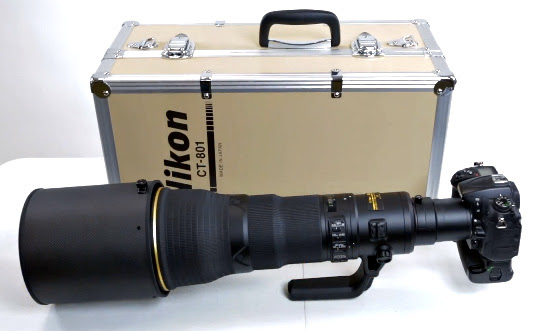
By Heinz Richter
I am certain that I am not the only one that has wondered how the production numbers of Leica equipment compare to that of their competitors. I have tried, but that information is very hard to obtain.
The latest figures that I was able to get for Leica are a total production capacity of 3,000 lenses per month or 36 thousand per year. Those arguably are impressive figures, but how do they compare to other manufacturers? I was able to obtain some information about Canon and Nikon.
Nikon recently announced that they have reached the mark of 70 million SLR lenses made since they were first introduced. That announcement came only six months after they published the manufacture of 65 million lenses. That means Nikon produced 5 million lenses in just 6 months or 10 million per year.
For Canon no such data could be found. However, they did publish the total number of SLR cameras and lenses made since 1987. These average out to 2.9 million lenses per year. Current production of cameras and lenses is substantially higher than these average figures. As a matter of fact, currently Canon makes more cameras and lenses than Nikon, but I have no exact figures.
Taking the 10 million Nikon figure for total annual lens production, in comparison to Leica they make almost 300 times the number of lenses per year. That actually means that Nikon makes approximately the number of lenses in one day that Leica makes in a whole year.
All lens elements are ground an polished individually
All Leica lenses and cameras are individually assembled by hand with
numerous tests and retests to assure complete adherence to the highest
tolerances in the industry,all with the total absence of of assembly lines
Photos by Marlies Amling and Heinz Richter
That is what mass production allows a manufacturer to do. However, mass production inevitably has to incorporate certain shortcuts. There is no way that Nikon or Canon or any other company that mass produces their lenses (and cameras) can even come close to the tolerance levels applied to Leica cameras and lenses. Ultimately it is this that sets Leica apart from their competition, and this is also part of the reason why it is so difficult for Leica to increase their production numbers.
Leica is all too often criticized for their prices. However, contrary to claims of being greedy or overcharging, these prices are the direct result of their production methods. Their bench made production is totally devoid of any assembly line work. All manufacturing and assembly steps are carried out by individuals in individual steps with multiple checks and rechecks. Only that way can the tight tolerances be assured, and it is these tight tolerances that are necessary to assure the increased performance that we expect from Leica equipment.
That isn’t to say that other companies do not make excellent equipment. As a matter of fact, especially lenses have attained performance levels that photographers could only dream about years ago. I regularly use two Nikon lenses on my Leica M 240, a 55mm and a 105mm Micro Nikkor besides several Leica lenses, and both of them are excellent.
Based on their marketing, most competitors of Leica must mass produce their equipment, including lenses. Leica has been able to apply noticeably tighter tolerances which are necessary to gain that edge in performance. That unfortunately is expensive. If the performance gains are worth the extra cost of Leica equipment is a decision that photographers have to make for themselves.
That is further underlined by some of the more exotic Nikon and Canon lenses. These simply do not sell in sufficiently large numbers to warrant mass production; they are made not unlike Leica lenses, but they still have the advantage that development and production costs can be subsidized by the sales of high volume equipment.


Canon EF 200-400 f/4L IS USM 1.4 lens and fitted case

Nikkor 800mm f/5.6E FL ED VR
One such lens is the Canon EF 200-400 f/4L IS USM 1.4x with a cost of $11,000 and $600 for the custom case. Nikon introduced the Nikkor 800mm f/5.6E FL ED VR lens at a cost of over $16,000. That puts either one of these lenses solidly in the price category that Leica is so often criticized for.
It is ironic that people often ask for Leica equipment at “competitive” prices. If Leica were to compromise their production methods to allow their equipment to be sold at lower prices, we would get equipment of performance levels as offered by other manufacturers. I for one am glad that this isn’t the case.
As the old adage goes, you get what you pay for. Leica is a very good example of that.
For other articles on this blog please click on Blog Archive in the column to the right
To comment or to read comments please scroll past the ads below.
All ads present items of interest to Leica owners.
_______________________________________________________________________
For other articles on this blog please click on Blog Archive in the column to the right
To comment or to read comments please scroll past the ads below.
All ads present items of interest to Leica owners.
_______________________________________________________________________

Buy vintage Leica cameras from
America's premier Leica specialist
Buy vintage Leica cameras from
America's premier Leica specialist
Click on image to enlarge
Order: info@gmpphoto.com
Please make payment via PayPal to GMP Photography
Click on image to enlarge
Order: info@gmpphoto.com
Click on image to enlarge
Order: info@gmpphoto.com
Click on image to enlarge
Order: info@gmpphoto.com
Please make payment via PayPal to GMP Photography
Click on image to enlarge
Order: info@gmpphoto.com
Please make payment via PayPal to GMP Photography
Click on image to enlarge
Order: info@gmpphoto.com
Please make payment via PayPal to GMP Photography























No comments:
Post a Comment